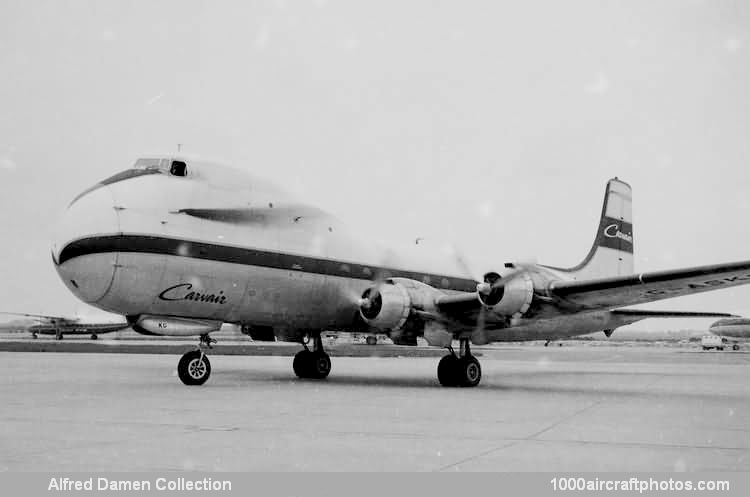08/12/2006. Remarks by Jack McKillop: "Originally, Douglas built this aircraft as a C-54A-15-DC Skymaster, USAAF s/n 42-72277, c/n 10382, and delivered it to the USAAF on August 24, 1944. After the war, it was purchased by the Norwegian airline Braathens SAFE on March 13, 1947, converted to a civilian airliner, registered LN-HAU and named "Norse Trader". It was sold to the US transatlantic cargo airline Seaboard & Western Airlines on October 17, 1950, registered N1221V and named "Oslo Airtrader". Trans Caribbean Airways, a supplemental carrier flying between the USA and Puerto Rico, leased the aircraft between January 20, 1953 and 1955.
On September 1, 1959, the aircraft was sold to a Lewman Corp who sold it to the Luxembourg company Interocean Airways in March 1961; the aircraft was registered LX-BBP. This company flew worldwide passenger and cargo charters and from March 1961 to November 1962, it was leased to the United Nations flying from Leopoldville, Congo during the political and social instability there.
On November 11, 1962, this DC-4 was sold to Aviation Traders, registered G-ASKG, and converted to ATL-98 Carvair c/n 10. It made its first flight on July 29, 1963 and was sold to British United Air Ferries on August 6, 1963, registered G-ASKG and named "Channel Bridge". The aircraft was leased to Cia Aeres Meridionale between December 28, 1965 and March 11, 1966 and renamed "Big Joe" by British Air Ferries on October 4, 1967. It was sold to the French airline Cie Air Transport on March 3, 1969, registered F-BRPT and named "Cdt Charles"; it was later sold to Transportes Aeriens Reunis on June 27, 1969.
British Air Ferries leased the aircraft on April 21, 1972 and repurchased it in March 1973 and again registered it G-ASKG. On February 25, 1975, it was sold to the Gabonese company Ste Anonyme de Construction and registered TR-LUP and subsequently stored at Brazzaville, Congo. It was later sold to the Congolese company Aero Services in 1980 and registered TN-ADX. The final two sales were to the Zairean (now Democratic Republic of the Congo) companies ECL Air in March 1993, registered 9Q-CTI, and Transair Cargo in April 1995. In July 1995, it was placed in storage at Kinshasa, Zaire, and scrapped in September 1995."
02/12/2005. Remarks by Alfred Damen: "This photo shows G-ASKG turning onto the Rotterdam Zestienhoven Airport platform during the summer of 1964. This was a very effective, if ungainly airplane. Aviation Traders developed the Carvair in response to Channel Air Bridge's requirement for an air ferry capable of transporting passengers and their cars between the United Kingdom and continental Europe.
Although its external appearance is quite different, the Carvair was a conversion of the Douglas DC-4 airliner or military C-54 Skymaster, large numbers of which were available after the introduction of jet airliners. Airframe from the wings rearward was a standard DC-4, except for a lengthened vertical tail for enhanced controllability. Major modifications on the forward fuselage centered on a new, lengthened nose section with a hydraulically operated cargo door which allowed nose loading for cars, and an elevated flight deck.
First flight of the Carvair conversion was June 6, 1961, and they entered service with British United Air Ferries, with which Channel Air Bridge had merged (it later became British Air Ferries and is now British World Airways) in March 1962. Deliveries to other operators included three for Aer Lingus (Ireland) and two for Aviaco of Spain. Others were operated by carriers in Australia, France, and Luxembourg.
One of the Carvairs, G-ARSF crashed December 28, 1962 while attempting to land at Rotterdam Airport. The terse words of the Dutch CAB (Civil Aeronautics Board) sum it all up: ....The aircraft lost height rapidly in a horizontal attitude when it reached the dike which forms the boundary of the airport. It hit the dike with its main wheels, bounced and flew on. The right wing then dropped and hit the ground. The aircraft turned and made a rolling movement to the right; it came to rest on its back. After the aircraft hit the ground for the second time, the right-hand wing broke off, and the fuselage of the aircraft came to rest upside down over the right-hand wing. The commander was killed, the co-pilot seriously injured, and the engineer and stewardess slightly injured. The fourteen passengers were uninjured."
